




placename:- Brandelhow
item:- tramroad
"Brandelhow (Lead Mines) / Shafts / Chimney / Tramway"
and to the S "Mill Race / Reservoir / Level"
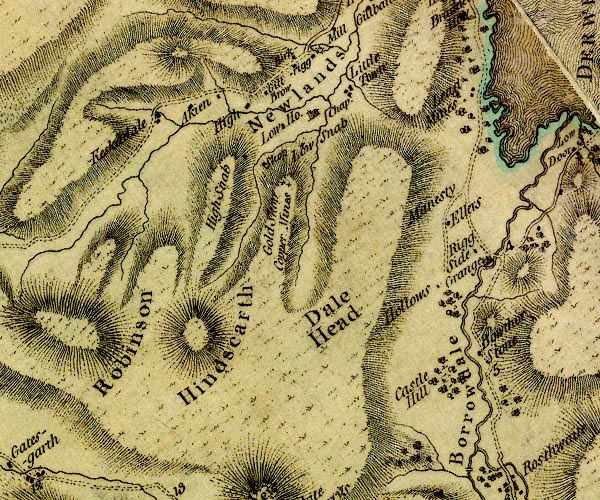
D4NY21NW.jpg
"Lead Mines"
block or blocks, labelled in lowercase; a hamlet or just a house
item:- Carlisle Library : Map 2
Image © Carlisle Library
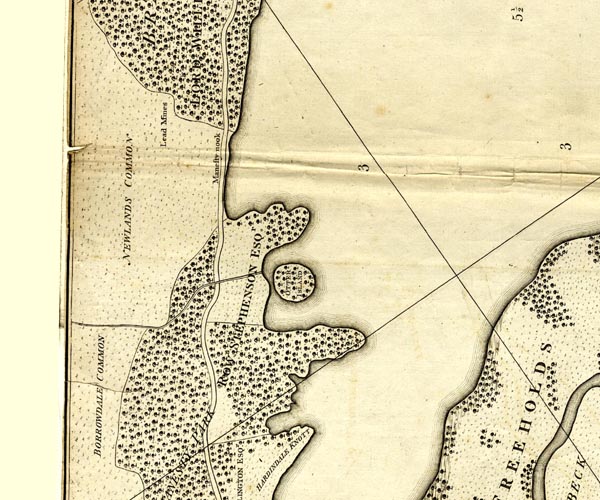
CL152519.jpg
"Lead Mines"
S edge of Brandlehow Wood
item:- private collection : 169
Image © see bottom of page
item:- geology
 goto source
goto sourcePage 154:- "... Veins of lead ore occur in several places; and have been worked between Skiddaw and Saddleback, in Thornthwaite, Newlands, and Buttermere; but one in the parish of Loweswater, and one below the level of Derwent Lake, are the most productive at present in this district."
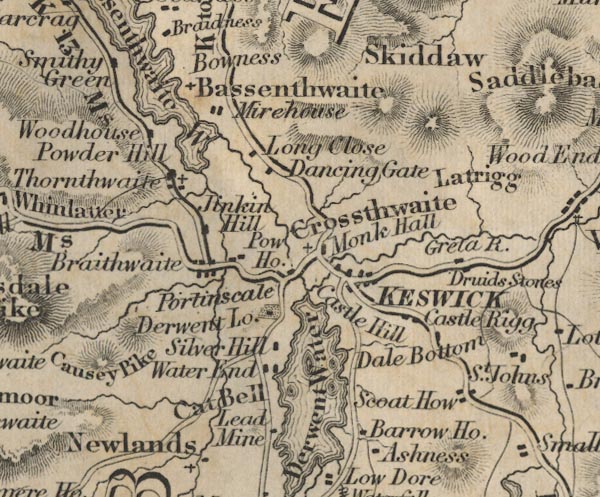
FD02NY22.jpg
"Lead Mine"
item:- JandMN : 100.1
Image © see bottom of page
placename:- Brandley Mine
placename:- Brandlehow Mine
item:- galena; cerussite; blende; iron pyrites; manganese; barytes; gold; gossan; Salt Level; steam engine; water wheel; lead ore; iron ore
 goto source
goto sourcepage 83:- "BRANDLEY, OR BRANDLEHOW MINE."
"This Mine is situated at the foot of Catbells, on the south-western shore of Derwentwater. The ores which it produces are Galena, Cerussite, and Blende; also Iron Pyrites, Manganese, and Sulphate Barytes, in small quantities; and traces of Gold have been found in the quartz and red gossan."
"The bearing of the vein is nearly due north and south, and its hade, of two feet per fathom, is towards the east. The vein varies generally, from two to six feet in width, and is well mineralised; a branch is thrown off on the eastern side, at the northern part of the mine, which yields about as much ore as the portion which holds to its true course. The branch, at the widest part explored, diverges as much as eight or nine fathoms."
"A number of quartz strings intersect the vein, nearly at right angles, and there is also a dyke of igneous rock, about twenty feet wide, running nearly due east and west, and as it contains a little galena and blende, it has no doubt borne an important part in depositing the ore in the vein; the quartz strings, too, have contributed their share, as a deposit of ore occurs at most of the points where they intersect the vein."
"..."
 goto source
goto sourcepage 84:- "..."
"Brandley is one of the most extensive mines in the Skiddaw Slates, and also one of the most ancient. There is no record of the date when it was first worked, but that it was anterior to the introduction of gunpowder into mining, is proved by the fact that some of the old workings at the northern end of the mine have been cut with stope and feather; and it has no doubt, with the exception of some short intervals, been wrought almost continuously since the time when those implements were in common use. It would seem that the ore was first discovered on the side of the mountain, above what is now the northern part of the mine, and near the dyke of igneous rock, as the ancient works, before mentioned, are at this place. The old men have sunk several small shafts, and in some places have cut away the vein for a considerable distance along the surface; these shafts have been unwatered afterwards by levels driven beneath them. As the ground above became exhausted, and new lower levels were driven, it would seem that fresh deposits of ore have been found in each of them; and ultimately a cross-cut was driven to the vein from the margin of the Lake, about 180 fathoms south of the point where the ore was first discovered, and 36 fathoms below it. This level, called the "Salt Level," was driven northward about 100 fathoms; and at several points along its course, the ground has been headed out to the surface. During the progress of this work ore was found south of the salt level cross-cut, and Mr. Tebay, who was then working the mine, sunk a shaft twenty fathoms deep, and erected a water-wheel to pump the water from it. Two sets of levels were driven from the shaft, north and south, at ten and twenty fathoms below the surface. These levels were not extended far to the south, as the shaft was not more than twenty-four fathoms from the southern boundary of the property; in this ground, however, a very rich deposit of ore was discovered, which is said to have measured upwards of four feet in thickness; but unfortunately it did not extend far either in length or depth. North of the shaft the levels were driven to a considerable distance, and a good deal of orey ground stoped out; but as the pumping machinery in use was insufficient to cope with water in the mine, it was abandoned."
"After an interval of a few years the mine was re-opened by the Keswick Mining Co., in 1848. They erected a thirty feet water-wheel, and extended all the levels northward; in doing this fresh springs of water were cut, and as the supply of surface water available for propelling the water-wheel was found to be altogether inadequate, it became necessary either to procure a more plentiful supply of water from a distance, or erect a steam engine. The"
 goto source
goto sourcepage 85:- "latter plan was adopted, and an engine of twenty-six horse power erected; the shaft was also sunk ten fathoms deeper, and another level driven off northward. About this time an unusually rich deposit of ore was discovered in the twenty fathom level, sixty fathoms north of the shaft. After heading out this ore up to the salt level, and attempt was made to sink upon it, with the aid of a pump, which was worked by means of iron rods, conducted up through the old workings to the surface, and thence over pullies placed along the ground to the engine, with which it was connected. But this machinery did not work well, and as the ground in the northern part of the mine appeared to be the most productive, it was determined to sink a new shaft. Accordingly a new shaft was sunk, fifty fathoms deep, and two additional lower levels were off northwards at forty and fifty fathoms below the surface. During the next ten years the whole of the five levels were driven away northwards, and the ground thoroughly explored. Numerous and extensive deposits of ore were discovered, some of them poor, but others very rich, containing ribs of ore measuring from eighteen inches to two feet in thickness; but these unfortunately were not of great extent, nearly all the deposits of ore appear to have been produced by strings, or feeders, which cross the vein almost at right angles, a mass of ore being deposited at each junction. The orey ground has been proved to extend upwards of 260 fathoms, and its limits have not been reached at either end."
"The average produce of the mine, when in full operation, was about 300 tons per annum, worth about L4,200; and it gave employment to from 70 to 80 men and boys."
"Brandley was not a successful mine, owing chiefly to the copious springs of water in it, which produced about 150 gallons per minute; sufficient to work a twelve feet water-wheel, by which the dressing machinery was propelled. The cost of pumping this water and drawing the ore from the mine, was about L800 per annum, sufficient to pay interest upon the capital invested; and it might have been avoided, because powerful water-wheels, or hydraulic engines, might have been erected, and an abundant supply of water obtained, either from the river Derwent or the Vale of Newlands, at no greater outlay than the original cost of the steam engine."
"After working day and night for fifteen years, the engine began to show signs of wearing out, and it became necessary to effect very extensive repairs in it, or procure new machinery. Several of the proprietors strenuously advocated the utilisation of the water power; but the majority, discouraged by their past want of success, were resolved to abandon the mine, which was accordingly done in 1864. Having remained closed twenty years, the mine was taken up by Mr. H. B. Vercoe, who formed a Company,"
 goto source
goto sourcepage 86:- "called the "Brandley Mining Co.," erected a 50-horse power steam engine, and commenced to pump the water from the mine. This was a formidable task, owing to the large extent of the excavations made by former workers. When the mine was cleared, the shaft was sunk ten fathoms deeper, and two more levels were driven off, north and south. The 40 fathom and 50 fathom levels were extended southward, and the 50 fathom level northward. A considerable extent of ground was stoped out, and about 600 tons of ore raised."
"The machinery required for crushing and dressing the ore was propelled by a 30 feet water wheel. The engine having proved unequal to the double task of pumping and drawing, a very fine beam-engine of 350 horse power was erected in the year 1888 to perform the first-named portion of the work."
"The shaft was afterwards sunk to the depth of 78 fathoms, and two more levels were driven off, northward for a distance of 75 fathoms, and southward about 10 fathoms, and some ore was raised, but the quantity of ground excavated in the stopes is only partially shown on the section."
"The ore obtained from this mine contains by analysis 83.5 per cent. of lead, and about 9 ozs. of silver per ton of 20 cwts. of ore."
placename:- Brandley Mine
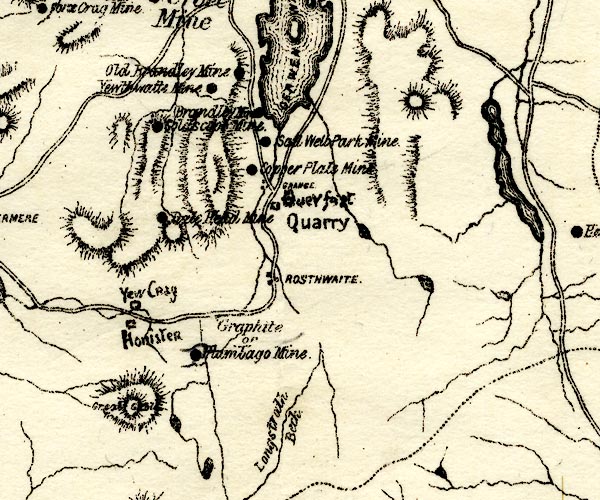
PST2NY21.jpg
"Brandley Mine"
mine symbol
item:- JandMN : 162.2
Image © see bottom of page
placename:- Brandley Mine
 click to enlarge
click to enlargePST301.jpg
Tipped in opposite p.1 of Mines and Mining in the English Lake District, by John Postlethwaite.
printed, bottom "BRANDLEY MINE. / TOP OF OLD SHAFT, 1862."
item:- JandMN : 162.3
Image © see bottom of page
placename:- Brandlehow Mine
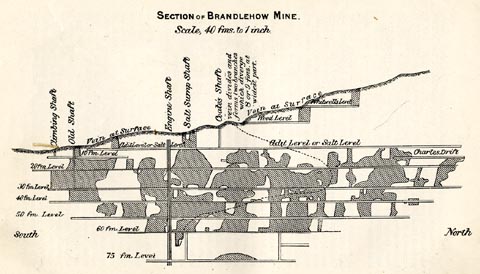 click to enlarge
click to enlargePST316.jpg
On p.82 of Mines and Mining in the English Lake District, by John Postlethwaite.
printed, upper centre "SECTION OF BRANDLEHOW MINE. / Scale, 40 fms. to 1 inch."
item:- JandMN : 162.18
Image © see bottom of page
placename:- Old Brandlehow Mine
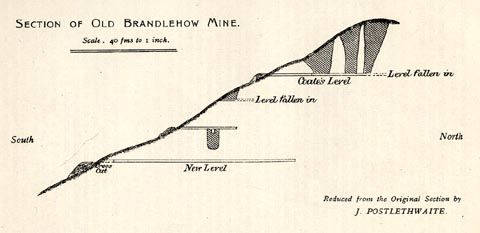 click to enlarge
click to enlargePST324.jpg
On p.107 of Mines and Mining in the English Lake District, by John Postlethwaite.
printed, upper left "SECTION OF OLD BRANDLEHOW MIONE. / Scale. 40 fms to 1 inch."
printed, lower right "Reduced from the Original Section by / J. POSTLETHWAITE."
item:- JandMN : 162.26
Image © see bottom of page
placename:- Brandlehow Mine
placename:- Whitwell's Level
item:- quartz
 click to enlarge
click to enlargeKMR03.jpg
"BRANDLEHOW MINE / WHITWELL'S LEVEL"
 click to enlarge
click to enlargeKMR04.jpg
"BRANDLEHOW MINE"
item:- private collection : 82
Image © see bottom of page
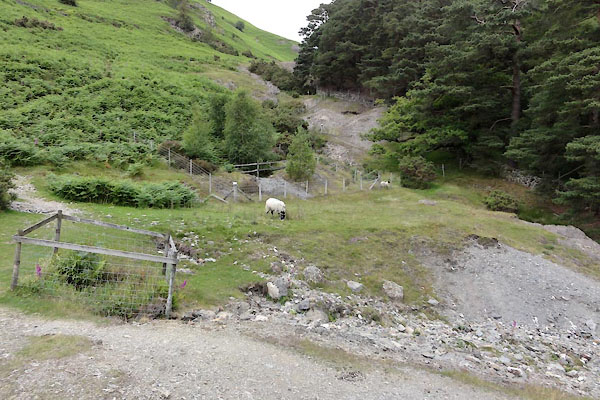
BVJ86.jpg courtesy of Ed Henderson
 quarry, Above Derwent
quarry, Above Derwent